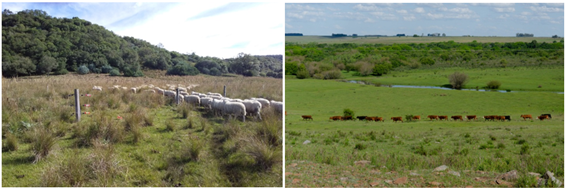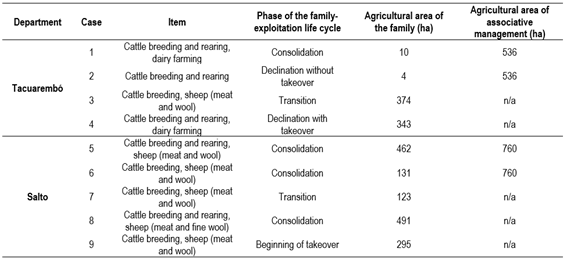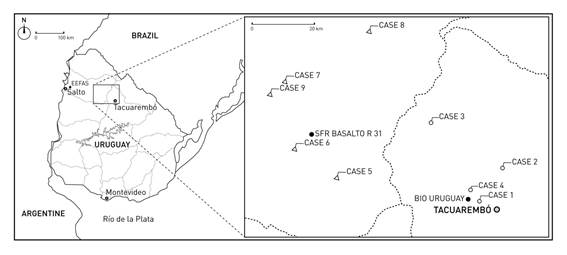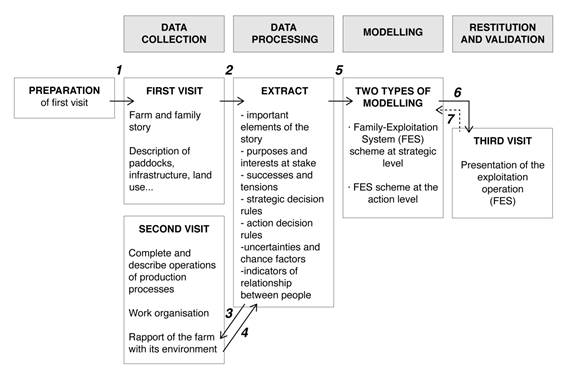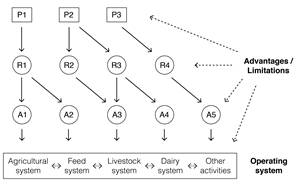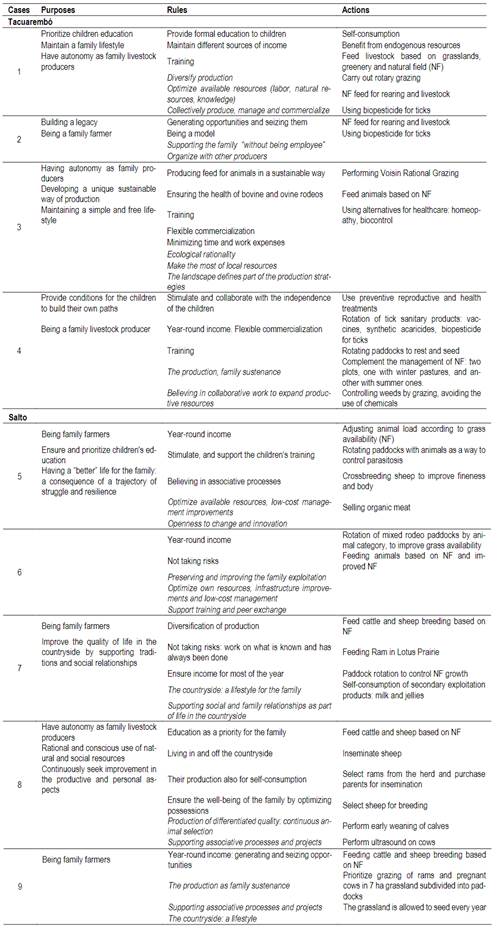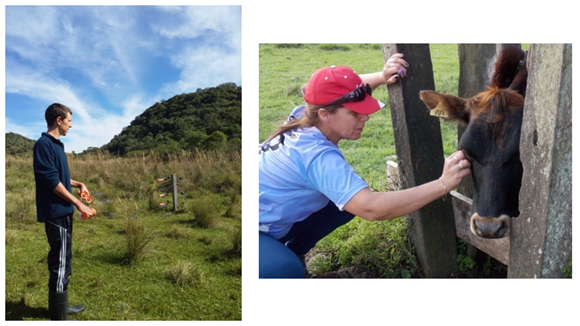1. Introduction
The development of agroecology as a scientific field has allowed identifying the fundamental ecological principles to design and manage agroecosystems that maintain productivity attributes, while preserving natural resources, that are socially and economically viable, and also culturally sensitive1. In Uruguay and many countries it arises as an alternative to the forms of production based on the green revolution2) as a response to climate change3; as a contribution to the management of biodiversity and the restoration of natural resources4, and more recently as a response to the pandemic crisis caused by SARS-CoV-25. From the development and expansion of agroecology, new fields of knowledge have emerged that delve into the agronomic, social, economic and physical impacts, as well as on animal and human health. These changes are related both to altering the regulation of nature's biological cycles and to ways of organizing, forming alliances, and innovating6)(7.
Faced with this situation, politicians, journalists and scientists started talking about agroecological transition (AT). Some authors consider AT as a concept or notion; Venegas and others8, for example, suggest defining it "as a process that aims to restore agroecological principles within the operation of an agroecosystem, under a dynamic conservation perspective, where practices and techniques typical of traditional systems can be combined with modernizing elements that help the operation of efficient production systems, capable of generating reliable and safe products, that protect the health of farmers and the environment, and that may have insertion in markets that increasingly value the effects of food on health".
For other authors, such as Tittonell9, Chia and Angeon10, AT is an object of study, and this is the line that the study follows and pretends to contribute to. Therefore, this research refers to AT as a study case. As a set of processes, practices, and simultaneous paths at different scales, levels and dimensions, combining actions at the level of both trophic structures of soil communities and families in the rural environment with their roles and responsibilities10)(11 with those transformations at the socio-technical, political and cultural level in the territories11)(12)(13. It must be considered, on the other hand, that AT is a phenomenon “situated” (in time and space), which means that the implementation of a new way of production depends on local natural and immaterial resources, and on the current situation and objectives of the families that frame their decisions to determine projects and paths towards transformation10, without forgetting the organizational and governance forms12.
In this regard, to study the ongoing transitions it is essential to understand the rationality and functioning of farms to co-conceive new production systems, new organizations, new advice and support systems, new public policies. This implies a methodological challenge; it means developing systemic approaches, valuing the articulation of knowledge and synergizing local and scientific knowledge so as to relearn to learn, through individual and collective dynamics that arise as a source of adaptation to local innovation situations14)(15. Also, it means promoting participatory approaches, research-action or research-intervention, where producers participate from the diagnostic phase to the evaluation phase, through the implementation of new practices together with researchers to create actionable knowledge16.
The term agroecology today means either a scientific discipline, an approach to agricultural practice or a political and social movement. These three dimensions are usually closely linked17. The implementation of the agroecological approach presents, as one of its conceptual bases, the issue of knowledge hybridization developing interdisciplinary studies and with local actors. Regarding the importance of hybridizing scientific knowledge with local knowledge1, authors such as Gaglio18, Akirch19 and Callon20 highlight the importance of scientific and empirical knowledge in innovation processes. Alter21, meanwhile, points out that local knowledge also allows for innovation.
Agroecology is part of a set of new approaches to agricultural development that vindicate the importance of stakeholders participating and being directly involved in innovation processes, since this is how local knowledge and the most advanced scientific knowledge are mobilized together11. How to do this mobilization, how to innovate? Meynard7 believes that agroecology has as its implicit objective that each producer designs his production system taking into account his family situation and his natural resources; promoting that actors of each territory organize to adjust the management of local resources. This allows food system actors to adapt their methods of production, processing and consumption, depending on the diversity of their purposes as a family.
This objective invites us to learn how producers decide and therefore how to study the decisions made by families. Several French researchers, such as Brossier and others22, and Chia and others23, propose that through the study of practices it is possible to identify the family producers' rationalities in use and not the theoretical models (justification). This makes it possible to understand decisions and build a decisional, operational and strategic modeling of farms, building more comprehensive models of action22)(23.
There are methodologies, such as the Global Approach to Agricultural Systems (GAAS), which have originated as a response to the need to "dialogue" with producers and to facilitate relationships between researchers and producers16. As detailed below, this methodology has been known and applied in Uruguay for more than 20 years24. Due to its comprehensive framework based on the study of producers' practices, this research suggested studying innovation processes and AT in the country. Since one of our hypotheses related to AT is that there are several paths and that these depend on the situation and the producers' projects, the study was oriented to test the relevance of the GAAS as an instrument that allows demonstrating the rationality and operation of the farms, in this case in the decision-making processes associated with AT. In this way, identifying the different paths of the AT set in Uruguay and for which producers need to be supported based on their practices.
There are 21,657 family farms in the country2, representing almost half of the total farms, considering that the number of total farms at the national level was 44,781 in 201125. Cattle (meat or milk) or sheep (meat and wool) is the main production for 65.4% of family farmers, most of them on a natural field forage basis25) (Figure 1). On the other hand, the law on the National Agroecology Plan (called "Plan Nacional para el fomento de la producción con bases agroecológicas") was adopted in 2018, promoted by the Agroecology Network, the Creole and Native Seeds Network, and the Latin American Society of Agroecology26. The purpose of this law is to strengthen food sovereignty and security and the agroecological production system, focusing on the family agricultural producer, and urban and suburban agricultural production systems.
In particular, the lifestyle of livestock families and their relationship with nature and the landscape are characteristics of a culture and tradition that prevail in decision-making27, and that can act as driving forces of change13. For this reason, it is especially important to understand the decision-making processes within families and to be able to support the AT of this type of producer.
Various researches on family farming in Uruguay analyze the question of its social, economic and ecological sustainability28)(29)(30)(31. However, few studies have been interested in the role played by the technical and organizational practices of Uruguayan family producers in the dynamics of AT, not only at the level of agricultural production but also livestock. Particularly in family farming, the strategic importance of researches that allow a better understanding of the producers' management and conservation of the natural field, and how to generate changes through collaborative work between technicians and family producers was pointed out already in 20143)(31.
Responding to this challenge, this article presents, as the main objective of the research, the results obtained from the use of the GAAS methodology as a tool to identify agroecological practices and transition paths that family livestock producers in northern Uruguay are experiencing. First, the methodology is presented, which focuses on the study of technical, social and organizational practices, to access the operating scheme and understand the decision-making processes in family-type production systems. Secondly, the results of the case studies are presented, which are discussed emphasizing the paths that can lead family producers toward an agroecological transition, testing a typology proposal. The conclusions take stock of the relevance of the methodology to identify socio-productive practices in the different types of family producers and for the implementation of processes of conception, selection and dissemination of innovations. The study ends with a reflection on the National Agroecology Plan and the contributions of the study to the elaboration of public policies that accompany producers who enter the virtuous circle of agroecology.
2. Material and methods
2.1 General approach of the research: agroecology from a practical point of view
Research on agroecology poses two major challenges: a methodological one, that is, how to study and analyze it through the socio-productive practices of producers; and a theoretical challenge, that is, generating actionable knowledge about the mechanisms of action of producer families allowing them to advance in a transition32.
The Theory of Adaptive Behavior of producers seems to be a relevant conceptual and theoretical framework to study the decision-making processes linked to the phenomenon of AT, since it allows a global and dynamic approach to the decision models of producers23. The theory uses the concept of the Family-Exploitation System (FES) and considers the farm and the family as a complex system (an organized whole) that does not respond to simple and uniform optimization criteria33. Acting as a particular species of collective subject and not as a simple aggregate of individuals, the family component is relevant to articulate the different logics present in the family-exploitation system, where work and family are deeply intertwined34. In particular, it focuses on the decisions of family producers (How are decisions made? What are the determinants of such decisions?), and makes it possible to understand the operation of family farms23. It is based on a postulate of coherence that can be summarized in the idea that producers have “reasons” to do what they do, and in the notions of purpose, project, situation and perception22. For these researchers, although the family determines the available workforce and the level of consumption needs, the decisions taken are, at the same time, the expression of a project and a situation. The project is defined as a complex set of objectives more or less hierarchical, not devoid of contradictions, but susceptible to evolution22.
From the methodological point of view, the interesting thing about this approach is that only from the producers' practices (“what they do”: their actions) can their vision be inferred (“what they seek”: their projects, purposes), and the perception they have about their objectives and their situation, understanding their decisions, needs and, from there, building a decisional, operational and strategic modeling.
As shown in Figure 2, there are two levels of action in the FES: that of the conceptual elaboration of decisions (decision system), and that of tangible operations (operating system), which function is to guarantee physical operations (actions)35. The operation of a farm is considered as chaining, at a given time, of decision-making in a set of actions (in their management practices) in view of fulfilling one or many objectives.
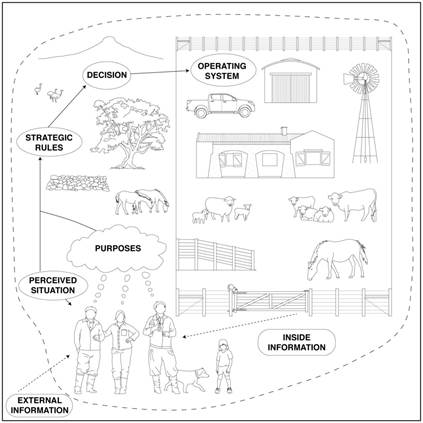
Figure 2: Conceptual outline used to construct the strategic operating model of a case study of a family livestock producer
From a systemic approach, through the GAAS it is intended to understand the operation of the FES by answering the question "how does the farm work?" Three intermediate questions are posed: what does the system do?, to try to describe (practical) actions and results; how does it do it?, understanding its organization and its capacity for regulation, and finally, why does it do it?, looking for the family purposes and the perception of the environment16.
Particularly, this study tries to describe socio-productive practices, understanding them as those concrete actions by which the producer and his family operate the farm, adapting the FES to internal and external changes (environment), in order to achieve the objectives set. It evidences what they do (their actions), what they respect in all their actions (their rules), and what they try to achieve in their life and work (their goals or purposes)36. Therefore, the interesting thing about the strategy is to see how the path is organized and how the management measures are modified while moving forward on that path and adapting according to the means available. That is, how producers produce, reproduce, and transform the ways of conceiving and evaluating things and actions that assure them, more or less, the management of their activities36
In Uruguay, this methodology has been used, since the 2000s, by a teaching team of the Experimental Station Dr. Mario A. Cassinoni of the Agronomy College, Universidad de la República, in the university program of territorial intervention, to study the socio-productive practices of family dairy and livestock producers, where the GAAS was not only part of the diagnosis, but also part of an academic cooperation project where the research was carried out by French students16)(37. Since 2004, the methodology has also been successfully applied by technicians of the Instituto Plan Agropecuario38, the main extension institute for livestock producers in the country.
2.2 Field Device
The application of the GAAS methodology to the theoretical sample of 9 cases of family farmers presented in this article constitutes the first part of the methodological device of an important research carried out from the qualitative paradigm, which combined different techniques in a second stage, such as focus groups and interviews with technicians and farmers.
The case studies are located in the region of influence of the Experimental Station of the Agronomy College in the department of Salto (ESACS), whose forage base is the natural field. Initially, exploratory interviews were conducted with qualified informants to select case studies, considering livestock families in different phases of the life cycle and that the initiatives to change their management practices were compatible with agroecological transition processes (for example, the use of bio-inputs and various practices of conservation of the natural field). The selected livestock families had as their main item the production of beef or sheep meat (individually or collectively) and different secondary items (dairy, wool, pigs, chickens) (Table 1). The proposal of Chia39 was used to characterize their life cycle, which considers that the decisions families make in their FES can vary according to their life stage, either a starting or installation phase or transition, consolidation, and decline of the FES (with or without takeover). Regarding the territorial location, Cases 1 to 4 are located in the department of Tacuarembó on sandy soils, and Cases 5 to 9 are in the department of Salto on superficial basalt soils (Figure 3).
Fieldwork was carried out by the main investigator and between May and October 2019. In much of this stage, two people participated in each visit, since a foreign researcher in the process of postdoctoral training joined as an observer. Before starting the application of the methodology, each family was visited as an introduction and to deliver documentation and an invitation to collaborate in the research. The application of the GAAS implied at least three visits to each exploitation and the preparation of monographs for each case. These monographs included the schemes of strategic functioning that were validated by each family on the last visit. The methodological itinerary presented in Figure 4 was broadly followed. An expanded description of the steps to follow for the application of the GAAS can be found in Chia and others16.
As a result of the collaborative work with families, these schemes allowed identifying the practices, rules and purposes of each FES. In Figure 5, as an example of how a scheme of operation of the FES is built, a flowchart can be observed that starts from the decisions on the operating system, where the arrows indicate the correspondence of the (practical) actions, which respond to rules and these to family purposes.
3. Results and discussion
Firstly, the results of the comparative analysis of the strategic operating models are presented, and secondly, the typology constructed based on the identification of common practices among farmers is discussed.
Based on the strategic functioning models developed for the 9 case studies, it was possible to systematize and understand the purposes, rules and actions of each family, and also identify which practices could be associated with the AT process. Table 2 highlights (in italics) those rules that are linked to practices compatible with AT processes, one of the selection criteria for livestock families; they will be considered to build an analysis typology presented in this section.
Family histories evidence, in the first place, the perception families have of their situation, of the family trajectory, the sense of belonging and their behavior when making decisions: “This farm belonged to my family, my paternal grandparents, and after, to my parents (…) you have to value and take care of your home” (C6); “When my wife inherited this land, it was only there that I felt that I was living in the countryside” (C8); “My husband inherited this fraction of the exploitation (…) and we came to settle here (…) the house was a shack (…) there was no water, no electricity” (C7); “My grandfather bought this farm, to leave it to his four children, I inherited part of this property, and another part I lease it to my sister (…) you learn by valuing what you have” (C9); “I had these 24 hectares of my family and we agreed to a MEVIR plan and built the house and the milking shed” (C4); “Our parents told us: finish high school and you decide, you can continue studying, here or abroad or stay in the countryside and produce, we chose the last option”(C3).
On the other hand, the experiences lived, some directly related to the health of some family members, lead them to make decisions that change the relationship of the family with nature: “When my father got sick I had to take over the exploitation, I had a very bad time, we stopped leasing and everything moved to this farm” (C5); “A few years ago I had a serious health problem (…), I see this farm as a part of us, we have to take care of it, I even have an organic vegetable garden!” (C8); “When Lucas was born we wanted to settle in the countryside” (C7); “On a visit at a producer's house on rational grazing, we saw that it was possible to do it at home, our uncle sent us two Voisin books, and we are implementing it” (C3). Although there is no emphasis on food safety aspects, the idea is intrinsic in the exchange about the decisions that are taken over time. But above all, they act as key promoters13 when making decisions.
It can be seen how management practices are also being adopted and adapted to each FES in response to experiences such as associative work and productive projects promoted by public and private institutions in the region. In many livestock families, associative work becomes an important pillar in life and decisions: “It is important to leave the house, participate in work sessions, everything adds up” (C4); “In 2008 I went to look for each of the dairy farmers in Tacuarembó to convince them to set up a group and we created the APLT, because it was the only way to sustain dairy” (C2); “The association gave us the possibility of breeding dairy heifers on another exploitation, we had only 10 ha (…), through the organization, the producer families could access different training, they called us the crazy for training” (C1); “I always say, the greatest richness of working like this in a group is the learning that you get from everything, because it is not the same to decide on your own, that you may get stuck with something and not know how to continue, than being several people sharing ideas, that will always have a better result” (C5).
The diversification of production is part of a lifestyle and it is naturalized in all families, from the most traditional and complementary practices for consumption such as the breeding of chickens, pigs, the production of raw milk, vegetable gardens and fruit trees, to the elaboration of cheese or jellies, which also diversify income. These practices reaffirm local knowledge, practices that are transmitted from generation to generation, and that are related to sustainable rural development not only at the farm level, but at the territory, since there is "barter" and direct sale to neighbors, which can be considered reservoirs of "ecosystem resilience"40)(41. In the participants' words, "beautiful things have been achieved with effort, (the neighbors) are all good people and personal relationships are important to share and help each other (...) with my mother we make jellies, she loves making dulce de leche and then we exchange with neighbors (...) this year we bought laying hens and we are selling eggs in town" (C7); "we have always had pigs for self-consumption and some are sold (...) as we do not have a cold chamber, everything is taken advantage of, raw milk is sold to the neighbors, the whey of the cheese is given to the pigs" (C1), "at home, we always had a vegetable garden, all the children collaborated and sometimes we bartered with the neighbors" (C2).
On the other hand, generally, the relationship with the ecological aspects of animal production takes symbolic dimensions, where the human/animal relationship and animal welfare are included, and even the relationship of humans with their land34, and this relation can be transformed into central aspects in the sustainability of production systems: "I love working with animals, especially I love the sheep" (C8); "neither dog nor lasso is used, stress must be reduced (in animals)" (C9); "we had successive frustrations, we used the whole package: cries, dogs, chemicals (...) we do not do it anymore" (C3), "we take care of the exploitation as my parents did" (C6).
Some of the practices carried out by livestock families tend to the conservation of natural resources and the reduction of the environmental impact on production, such as the rotation of paddocks or Voisin rational grazing, prioritizing food in the natural field, the use of biopesticide for ticks, etc.: “The project on climate change allows us to continue with the paddocking for rational grazing (…) we seek to produce more and more sustainably” (C3); “I have been selling meat to the slaughterhouse for about 10 years (…) I want to be credited as organic meat. I don't use [chemically synthesized pesticide for ticks] and I got more excited about the idea when the buyer of the wool told me that you get paid up to a few cents more on the wool.” (C5)
In a comparative analysis of the 9 cases, based on the operating schemes of the FESs, it was possible to identify actions that respond to rules compatible with agroecological management, and which in turn can be considered as promoting innovations towards an AT in the region. Based on the information obtained, a typology was developed that allows exploring the diversity of AT paths in family livestock producers. Following Weber's proposal of ideal types in compressive and systematic theory, this typology is used as an instrument that allows the construction of new hypotheses (or intermediate hypotheses), in the understanding of complex phenomena that occur in uncertain situations42.
Therefore, the typology presented in this study was made to understand agroecological practices under construction. So, it is a theoretical proposition, constructed qualitatively. It is not statistically representative but tries to synthesize ideas that allow understanding and interpreting the diversity of agroecological practices found.
In this regard, the cross-sectional analysis of the 9 monographs allowed identifying and understanding the actions of families (and not only productive practices), and thus finding ways of action that were common and varied. For example, some of the common actions were: belonging to an organization, having an interest in training in certain practices, optimizing the use of its resources, minimizing the entry of external inputs, and providing education to their children, which is compatible with the results of previous research carried out with this methodology in the region3)(34.
3.1 FES typology of operation and paths for the agroecological transition
A first analysis was carried out to understand the socio-productive practices of family farmers in northern Uruguay, and identify those that represent one or more paths of transition to agroecology. The result of this first analysis shows that, for the same purpose, the rules and actions can be several, and could even be differentiated between more “innovative” and more “traditional” practices.
As explained in previous sections, the typology allows grouping the FESs according to the similarity of operation, comparing these empirical data43 and, thus, understanding if there is a single path or more than one by which the FESs move towards an agroecological model. To build this typology, the data were analyzed taking into account two dimensions within their management practices: (i) reproduction and animal health (sheep and cattle); (ii) natural field management (production and use of forage supply).
On the other hand, the common strategic rules associated with the socio-productive practices identified in the first analysis were grouped by similarity of criteria (as proposed by Dieguez3), and three strategic macro-rules were obtained that are related to: (a) Social and productive integration, since part of socio-productive development, technological change has to do with rural organization according to the result of the analysis of its FES ("supporting associative processes and projects so as to improve", "supporting collaborative work to expand productive resources"); (b) Supporting productive changes, those socio-productive practices related to the search of technologies to improve the quality of their product without losing sustainability of the system, minimizing risks ("openness to change and innovation", "supporting continuous selection for a differentiated quality production, producing more food for animals in a sustainable way"); (c) Improving quality and lifestyle, explains that decisions on practices at the productive level are related to the lifestyle that families want to have and preserve, anchored in the family tradition ("the countryside: a way of life for the family", "production as the family sustenance", "preserving the family property and improving it").
Finally, the macro-rules and socio-productive management practices give clues to the different paths that may exist in the transition to agroecological production. The typology comprises three types of pathways to AT: (i) diversification; (ii) biodiversity management, and (iii) traditional practices. Below, the three types built are presented, and the distribution of the 9 cases in them (Table 3).
3.2 The paths of the agroecological transition: From diversification to maintaining traditional practices passing through innovation
3.2.1. Agroecological transition from diversification
Management practices and strategies can be thought of as valuing natural resources, but with models that emerged from collective action, such as the use of bio-pesticide for ticks. Environmental care practices have several objectives: to increase the quality of the product to be commercialized, to take advantage of the potential of the fields without having to invest with external inputs (efficiency of land use), and to start moving forward on paths that make their products better for the life quality of people. And from this, those innovations arise, for example, the use of biological insecticide for ticks, not using glyphosate anymore and performing rotary grazing with differentiated paddocks. The decisions of the families who carry out these practices serve the desire to continue living in the countryside and to be able to give their children the possibility to do what they want, but always trying to leave them a legacy.
3.2.2. Agroecological transition from biodiversity management
Management practices and strategies are expressed in the complexity of systems and suggest managing biodiversity with a greater emphasis on technology. Changes in their management practices seek purposes that relate to strong family experiences. These are changes that follow a defined and very clear path; for example, Voisin rational grazing, continuous grazing with load management according to grass availability, coprological analysis, tattooing of sheep, very little use of external inputs, category management of animals, use of biological pesticide for ticks (in other parts there is a very low incidence of tick, therefore, there is no use of chemically synthesized products for tick treatments).
These practices are associated with the experiences of certain families, ranging from the need to generate income to health problems that change these producers' lives and the need to generate new things. Some phrases of their statements reveal the interest of these families to support changes (innovations) in the search for ways to produce sustainable products.
3.2.3. Agroecological transition from the maintenance of traditional practices
They go through the relationship of the family with their own land, with the area in which they lived all their lives, the practices' logic can be considered more traditional, as peasants. Practices are carried out the way they have always been, but they can change from year to year, and even though “it was always done that way”, decisions are not always the same. These are families that are there because they were always there, because their parents shared their knowledge and love for the countryside.
The identified backgrounds from socio-productive management practices show that there is not one pathway to agroecological production. Here we identified three paths, one that supports the transition from the exchange and diversification of production; another that supports innovation, in environment-conservative technologies, optimizing the use of its resources; and a third that supports the transition from family traditions, so as not to destroy an exploitation that has sustained a particular lifestyle (Figure 6).
Now, these paths are not static, or unique, they are identified from the particular realities of these families. This does not mean that they cannot take other alternatives in the future, during this AT process, precisely due to the implementation of public policies, or the future implementation of the National Agroecology Plan. In addition, at the territorial level, there are exchanges between different social actors, whether technical professionals or peers, that can also act as drivers of change.
The typology built can be used as a starting point for diagnostics and for the application of research-action-participatory or co-innovation methodologies, confronting family producers with these types, exchanging and learning the appreciation they have about their own practices. It should be noted that all three types were validated with producers and technicians in group work (article in progress).
The GAAS methodology is highlighted as appropriate for the approximation to the FES of family producers of any production item23. In the country, it has been mostly tested in dairy and livestock producers, but recently it is being used for research in horticultural-livestock systems in the south of the country.
Table 3: Grouping of technical-productive management practices according to two productive dimensions
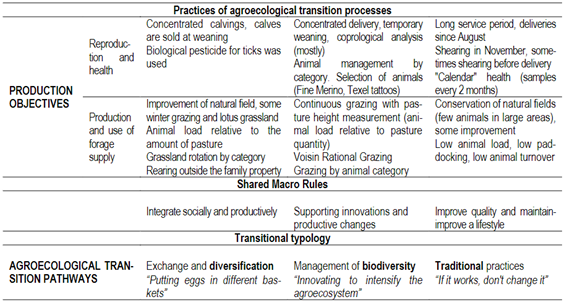
4. Conclusions
As illustrated by the results presented, the GAAS allows accessing the farmers' strategies, their socio-productive practices and, therefore, the decision model. The results are encouraging to understand and identify the paths of the AT. Although it requires significant collaboration between the researcher and the family farmers to outline their management practices and approach the action models, this collaborative work time manages to identify agroecological bases and regularities between the cases. The methodology allows learning and academically enhancing the knowledge of the livestock producer about environmental care.
The typology built from the similarities and differences between the socio-productive practices of the cases analyzed allowed finding more than one possible path by which farmers are moving towards agroecology. Case studies (monographs) are the first necessary step to understand the decisions of livestock families, the meaning of their practices, and why they do what they do. The rules and purposes of each family defined a “set” of practices and action strategies that relate to agroecology and that allow visualizing different “paths” of AT.
Regarding these paths, the results of each family history evidence the interest in an environmentally friendly production in response to the purposes of each case. In “diversified agroecological” practices, the path is represented by the interest that families have in production as an improvement in life quality, linked to the journey of the organizations to which they belong, since changes are the result of collaborative work. In “agroecological practices based on biodiversity management”, the path to agroecology is determined by the background of the families who individually introduce new practices driven by environmentally productive projects, and are convinced that this is the path of change (technological change). And finally, in “traditional agroecological” practices the path is more diffuse and it is reflected in the conservation of the natural field; the changes are latent, but the way forward and the speed will depend on proposals and innovations that do not require changing their lifestyle or transforming their purposes.
Regarding the elaboration of public policies and the support of family farmers who enter the virtuous circle of agroecology, the consideration of the typology developed, which represents different ways to practice agroecology, would allow better orientation of actions and, thus, greater efficiency in AT processes. The implementation of the National Agroecology Plan opens doors in Uruguay to transformations in family production towards agroecologically-based production systems, since these family producers are the main subjects of the law. It is necessary, then, to know not only who and how many these subjects are, but their strategies and productive purposes, as well as their decision-making, their territory and the exchange with other social actors.
It is also necessary to deepen, in the future, the research on socio-productive management practices that can be part of an AT. In this way, it will be possible to specify the technical, organizational and social conditions that structure these possible AT pathways. Likewise, from a more territorial and comprehensive perspective, we can question the time it takes to analyze the cases, and the possibility of carrying out a questionnaire that allows collecting information more quickly on a larger number of producers.














